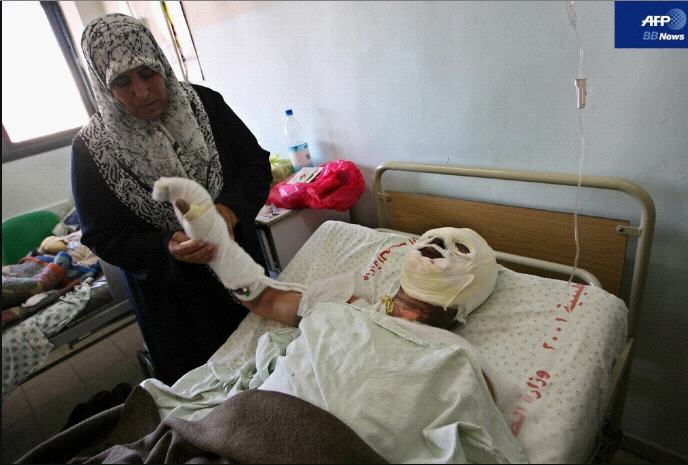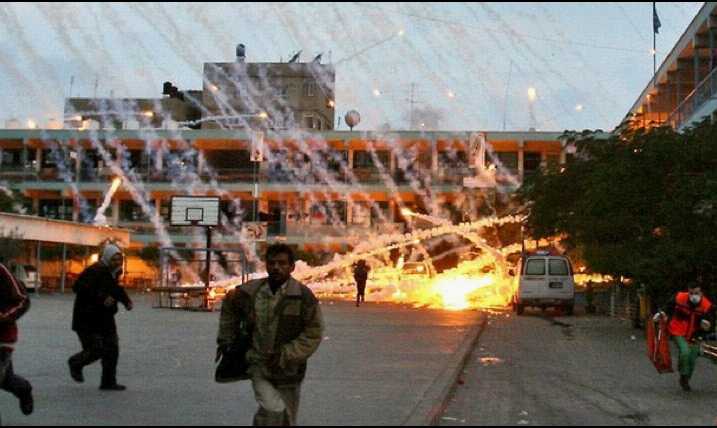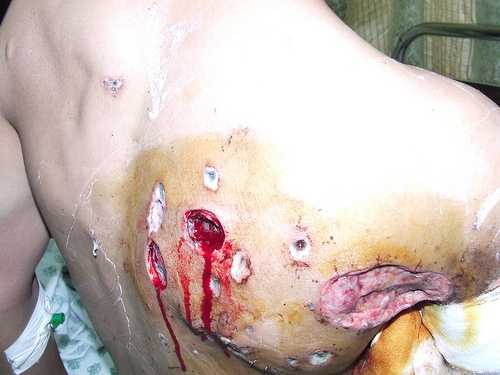Gaza: Death's Laboratory
アメリカの国際問題専門シンクタンクである‘フォーリン・ポリシー・イン・フォーカス’(FPIF)のコラムニストConn Hallinan の報告。
Gaza: Death's Laboratory
ガザは死の実験室
=================================================================
Conn Hallinan | February 11, 2009
http://www.fpif.org/fpiftxt/5862
Editor: John Feffer
Foreign Policy In Focus www.fpif.org
Erik Fosse, a Norwegian cardiologist, worked in Gaza hospitals during the recent war."It was as if they had stepped on a mine," he says of certain Palestinian patients he treated. "But there was no shrapnel in the wound. Some had lost their legs. It looked as though they had been sliced off. I have been to war zones for 30 years, but I have never seen such injuries before."
ノルウェー人の心臓内科医Erik Fosseは、今度の戦争の間ガザの病院で働いていました。「まるで地雷を踏んだようでした。」と彼が治療した或るパレスチナ人患者について語ります。 「しかし、傷には爆弾のかけらは全くありませんでした。 或るものは脚を失いました。 まるでそれらは切り取られたかのように見えました。 30年間にわたって交戦地帯に行きましたが、私はこれまで、このような傷害を一度も見たことがありません。」
Dr. Fosse was describing the effects of a U.S. "focused lethality" weapon that minimizes explosive damage to structures while inflicting catastrophic wounds on its victims. But where did the Israelis get this weapon? And was their widespread use in the attack on Gaza a field test for a new generation of explosives?
Fosse博士は合衆国製「集中された致死率」兵器の効果について説明していました、構造物へのダメージを最少にし、その一方で、苦痛で破滅的な傷害を犠牲者に与えます。しかし、どこでイスラエルはこの兵器を手に入れたのでしょうか? ガザ攻撃での広範な使用は、この次世代爆弾の野外実験だったのでしょうか?
DIMEd to Death
"密かに告げ"られた死
The specific weapon is called a Dense Inert Metal Explosive (DIME). In 2000, the U.S. Air Force teamed up with the University of California's Lawrence Livermore National Laboratory. The weapon wraps high explosives with a tungsten alloy and other metals like cobalt, nickel, or iron in a carbon fiber/epoxy container. When the bomb explodes the container evaporates, and the tungsten turns into micro-shrapnel that is extremely lethal within a 13-foot radius. Tungsten is inert, so it doesn't react chemically with the explosive. While a non-inert metal like aluminum would increase the blast, tungsten actually contains the explosion to a limited area.
この特殊兵器はDense Inert Metal Explosive高密度不活性金属爆薬(DIME)と呼ばれます。 2000年に米空軍はカリフォルニア大学のローレンス・リバモア国立研究所とチームを組みました。 兵器は、高性能爆薬とコバルト、ニッケル、または鉄のような他の金属を含んだタングステン合金を、炭素繊維/エポキシ樹脂の中に装填しています。爆弾が爆発すると、容器は気化しますが、タングステンは13フィート以内では非常に致命的なマイクロ榴霰弾に変わります。タングステンは不活性です、そのため、爆薬とは化学的に反応することはありません。アルミニウムのような不活性ではない金属が爆発を大きくするのとは対照的に、タングステンはじっさい、爆発領域を限定するために充填されているのです。
Within the weapon's range, however, it's inordinately lethal. According to Norwegian doctor Mad Gilbert, the blast results in multiple amputations and "very severe fractures. The muscles are sort of split from the bones, hanging loose, and you also have quite severe burns." Most of those who survive the initial blast quickly succumb to septicemia and organ collapse. "Initially, everything seems in order…but it turns out on operation that dozens of miniature particles can be found in all their organs," says Dr. Jam Brommundt, a German doctor working in Kham Younis, a city in southern Gaza. "It seems to be some sort of explosive or shell that disperses tiny particles…that penetrate all organs, these miniature injuries, you are not able to attack them surgically." According to Brommundt, the particles cause multiple organ failures.
しかし兵器の効果範囲では、それは過度に致命的です。 ノルウェー人の医師 Mad Gilbert によれば、爆破は(人間の体に)複数箇所の切断と「非常に厳しい破砕」をもたらします。 「筋肉は骨から離れて、垂れ下がり、そして、重傷の火傷を負います。」 最初の爆発で死を免れた人の大部分は、敗血症と器官不全で死に至ります。
「最初は、みな順序どおり・・・でも、手術に入ると、あらゆる臓器の中に数ダースにも及ぶ微小な粒子が発見されるという事態になります」
と、ガザ南部の都市JKham Younisで働いている Jam Brommundt博士はいいます。
「それは、爆薬のかけらなのか、それとも小さな破片として散らばった弾殻のようにも見えますが・・・総ての臓器に浸透し、微小な傷害となり、外科的な取り組みを不可能にさせます。」
Brommundt博士によれば、この(タングステン合金)粒子が多臓器不全を起こすというのです。
If by some miracle victims resist those conditions, they are almost certain to develop rhabdomyosarcoma (RMS), a particularly deadly cancer that deeply embeds itself into tissue and is almost impossible to treat. A 2005 U.S. Department of health study found that tungsten stimulated RMS cancers even in very low doses. All of the 92 rats tested developed the cancer.
犠牲者がそんな条件に抵抗して奇跡的に生き残ったとしても、致命的ガンである横紋筋肉腫(RMS)を引き起こすことが特徴として認められています、それは組織の奥深くに埋め込まれたガンで、殆ど治療が不可能です。2005年の合衆国保健省の研究では、非常に低い投与量でもタングステンがRMS癌を誘引することがわかりました。動物実験に掛けられた32匹のラット全てにガンが発生しました。
While DIMEs were originally designed to avoid "collateral" damage generated by standard high-explosive bombs, the weapon's lethality and profound long-term toxicity hardly seem like an improvement.
標準の爆弾で発生する「巻き添え」の損害を避けるように、元々DIMEが設計されていたにもかかわらず、兵器の致死性と深くて長期の毒性は改良されたようにはほとんど見えません。
It appears DIME weapons may have been used in the 2006 Israeli invasion of Lebanon, but not enough to alarm medical workers. But in Gaza, the ordinance was widely used. Al-Shifta alone has seen 100 to 150 victims of these attacks.
DIME兵器が2006年のイスラエルのレバノン侵攻で使われたことは知られてますが、医療従事者への警鐘は充分ではありませんでした。しかし、ガザではこの武器が広範に使われました。Al-Shifta 病院ひとつだけでもDIMEの攻撃を受けた犠牲者は100人から150人もいました。
Gaza as Test
実験としてのガザ
Dr. Gilbert told the Oslo Gardermoen, "there is a strong suspicion…that Gaza is now being used as a test laboratory for new weapons."
「新しい兵器のテストをする実験室としてガザが今使用されているという強い疑念が …あります。」と、ギルバート博士はオスロGardermoen紙に語りました。
DIME is a U.S. invention. Did the Israelis get the weapons from the United States, or did they design similar ones themselves? Given the close relations between the two militaries, it isn't unlikely that the U.S. Air Force supplied the weapons or, at least, the specifications on how to construct them. And since the United States has yet to use the device in a war, it would certainly benefit from seeing how these new "focused lethality" weapons worked under battlefield conditions.
DIMEは合衆国の発明品です。 イスラエルが合衆国からこの兵器を手に入れたのか、あるいは同様のものを自分で設計したのか? 両国の軍の親密な関係を考えると、米空軍がそれらDIMEを提供したか、すくなくとも組み立て方の仕様を供与したということは、ありえない話ではありません。 そして、合衆国がこの兵器を戦争にまだ使用していないのですから、この新型の「集中させた致死率」兵器が、実際の戦場の条件でどう働くかを見ることは、確かな利益ということになるでしょう。
Marc Garlasco, Human Rights Watch's senior military advisor, says "it remains to be seen how Israel has acquired the technology, whether they purchased weapons from the United States under some agreement, or if they in fact licensed or developed their own type of munitions."
ヒューマン・ライツ・ウオッチの先任軍事アドバイザー Marc Garlasco は言います。
「イスラエルがどのように技術を取得したかはまだ不明です、何らかの合意の下に合衆国からこの兵器を購入したのか、あるいは、イスラエルが自国タイプの兵器を実際に認可し開発したのか。」
DIME weapons aren't banned under the Geneva Conventions because they have never been officially tested. However, any weapon capable of inflicting such horrendous damage is normally barred from use, particularly in one of the most densely populated regions in the world.
公式に一度もテストされたことがないので、DIME兵器はジュネーブ条約で禁止されていません。 しかしながら、そのような恐ろしい傷害を課すことができるどんな兵器も通常は使用が禁じられます、特に世界で最も人口密度の高い地域で使うことについては。
For one thing, no one knows how long the tungsten remains in the environment or how it could affect people who return to homes attacked by a DIME. University of Arizona cancer researcher Dr. Mark Witten, who investigates links between tungsten and leukemia, says that in his opinion "there needs to be much more research on the health effects of tungsten before the military increases its usage."
もう一つの問題は、タングステンが環境でどれくらい長く残っているか、あるいは、DIMEによって攻撃された家に戻った人々に、どのような影響を与えるか、誰も知らないことです。 タングステンと白血病との関連を研究しているアリゾナ大学の癌研究者マーク・ウィッテン博士は主張します。
「軍が利用を増大させる前に、タングステンの健康への影響をもっと研究する必要があります。」
Beyond DIMEs
DIMEのむこう
DIMEs weren't the only controversial weapons used in Gaza. The Israeli Defense Forces (IDF) also made generous use of white phosphorus, a chemical that burns with intense heat and inflicts terrible burns on victims. In its vapor form it also damages breathing passages. International law prohibits the weapon's use near population areas and requires that "all reasonable precautions" be taken to avoid civilians.
DIMEは、ガザで使用され論議を呼んだ唯一の兵器ではありません。 イスラエル国防軍(IDF)はDIMEと同じように、高温で燃えてひどい火傷を犠牲者にもたらす化学物質、白リンを広範に使いました。白リンは蒸気の状態では気道を傷害します。 国際法では、人口密集地域の近くでの兵器の使用は禁止され、民間人の犠牲を避けるための「考え得るあらゆる配慮」をなすことが求められています。
Israel initially denied using the chemical. "The IDF acts only in accordance with what is permitted by international law and does not use white phosphorus," said Israel's Chief of Staff Gabi Ashkenazi on January 13.
イスラエルは、初めは化学物質の使用を否定しました。
「イスラエル国防軍は、国際法が何を許容しているかに沿った行動しかしていません。白リンは使用していません。」
と、イスラエル幕僚長のGabiアシュケナージは1月13日に言いました。
But eyewitness accounts in Gaza and Israel soon forced the IDF to admit that they were, indeed, using the substance. On January 20, the IDF confessed to using phosphorus artillery shells as smokescreens, as well as 200 U.S.-made M825A1 phosphorus mortar shells on "Hamas fighters and rocket launching crews in northern Gaza."
しかし、ガザとイスラエルの目撃者の証言は、まもなくイスラエル国防軍IDFに、本当はその物質を使用していたことを認めさせました。 1月20日にイスラエル国防軍IDFは、煙幕としてリン砲弾を使用したことを告白し、加えて、「北ガザのハマス戦闘員とロケット発射クルー」にむけ、200基のアメリカ製 M825A1リン迫撃砲弾を発射したと告白しました。
※ M825A1は迫撃砲弾ではないが、ニュースソースのイスラエルのハーレッツ紙が"motar"(迫撃砲)と報じた。IDFスポークスマンが間違えたのかもしれない。
Three of those shells hit the UN Works and Relief Agency compound on January 15, igniting a fire that destroyed hundreds of tons of humanitarian supplies. A phosphorus shell also hit Al-Quds hospital in Gaza City. The Israelis say there were Hamas fighters near the two targets, a charge that witnesses adamantly deny.
そのうちの3個の砲弾が、1月15日に国連難民救済機関の複合施設に着弾し、何百もの人道的援助物資を破壊する火災を起こしました。 また、リン砲弾はガザ市のアル・クッズ病院にも当りました。 イスラエル側は、目撃者の強硬な否定に抗議して、これら2箇所の近くにはハマスの戦闘員がいたといいます。
Donatella Rovera of Amnesty International said: "Such extensive use of this weapon in Gaza's densely-populated residential neighborhoods…and its toll on civilians is a war crime."
アムネスティ・インタナショナルのDonatella Roveraは言いました。
「ガザの人口密度が高い住宅地にこの兵器を大規模に使うことは …そして民間人に犠牲を課すことは、戦争犯罪です。」
Israel is also accused of using depleted uranium ammunition (DUA), which a UN sub-commission in 2002 found in violation of the Universal Declaration of Human Rights, the UN Charter, the Geneva Conventions, the International Convention Against Torture, the Conventional Weapons Convention, and the Hague Conventions against the use of poison weapons.
イスラエルはまた、劣化ウラン弾(DUA)の使用でも非難されています。劣化ウラン弾は2002年の国連サブコミッションで、有毒兵器の使用を禁止する、世界人権宣言、国連憲章、ジュネーブ条約、拷問に対する国際会議、通常兵器に対する国際会議、およびハーグ会議などに違反しているとされました。
※ 今回のガザ侵攻では、アラブ諸国が非難。だが劣化ウラン弾(DUA)使用はまだ確認されていない。国際原子力機関IAEAが現在調査中。
ICBUWの声明(2009年1月23日)http://www.bandepleteduranium.org/en/a/223.html
DUA isn't highly radioactive, but after exploding, some of it turns into a gas that can easily be inhaled. The dense shrapnel that survives also tends to bury itself deeply, leaching low-level radioactivity into water-tables.
劣化ウラン弾DUAは高い放射性を持ちませんが、爆発した後に一部が容易に吸入できるガス(微粒子)に変わります。 また、生存者の体内深くに埋まった高密度な弾の破片は、低レベルな放射性物質を地下水面に浸出させます。
※ 原文でたぶん動詞が一つ欠落か?
War Crimes?
戦争犯罪か?
Other human-rights groups, including B'Tselem, Gisha, and Physicians for Human Rights, charge that the IDF intentionally targeted medical personal, killing over a dozen, including paramedics and ambulance drivers.
他の人権団体、B'Tselem、Gisha、および人権のための医師団などは、イスラエル国防軍が医療従事者を故意に狙って、補助員や救急車のドライバーを含めて12人以上を殺したと抗議しています。
The International Federation for Human Rights called on the UN Security Council to refer Israel to the International Criminal Court for possible war crimes.
人権のための国際連盟は呼びかけました。国連安全保障理事会がイスラエルを考え得る戦争犯罪で国際刑事裁判所にかけるよと。
Although the Israelis dismiss the war-crimes charges, the fact that the Israeli cabinet held a special meeting on January 25 to discuss the issue suggests they're concerned about being charged with "disproportionate" use of force. The Geneva Conventions require belligerents to at "all times" distinguish between combatants and civilians and to avoid "disproportionate force" in seeking military gains.
イスラエルは戦争犯罪容疑を否定しますが、イスラエルの内閣が1月25日にこの問題に取り組むための臨時閣議を開催したという事実は、彼らが「不均衡な武力行使」での告発を懸念していることを示します。 ジュネーブ条約は「いかなる時」も戦闘員と民間人を分けて、軍事の利得を求める際にも「不均衡な武力行使」を避けることを交戦国に求めています。
Hamas' use of unguided missiles fired at Israel would also be a war crime under the Conventions.
ハマスのイスラエルに向けられた非誘導ミサイルの使用もまた、国際会議の下では戦争犯罪だといえるでしょう。
"The one-sidedness of casualty figures is one measure of disproportion," says Richard Falk, the UN's human rights envoy for the occupied territories. A total of 14 Israelis have been killed in the fighting, three of them civilians killed by rockets, 11 of them soldiers, four of the latter by "friendly fire." Some 50 IDF soldiers were also wounded.
「死傷者数がワンサイドだということは、不均衡の1つの目安です。」と、占領地への国連の人権使節リチャード・フォークは言います。 合計14人のイスラエル人が戦闘で死にました。そのうち3人はロケットで死んだ市民です。11人は兵士ですが、そのうちの4人は「同士討ち」による犠牲です。そして、約50人のイスラエル国防軍兵士が負傷しました。
In contrast, 1,330 Palestinians have died and 5,450 were injured, the overwhelming bulk of them civilians.
対照的に、1,330人のパレスチナ人が死に、そして、5,450人が負傷しました。彼らの大多数は民間人です。
"This kind of fighting constitutes a blatant violation of the laws of warfare, which we ask to be investigated by the Commission of War Crimes," a coalition of Israeli human rights groups and Amnesty International said in a joint statement. "The responsibility of the state of Israel is beyond doubt."
「この種の戦闘は、戦争法が既定する甚だしい違反を構成します。私たちは、戦争犯罪委員会によって調査されるよう求めます」と、イスラエルの人権擁護団体とアムネスティ・インタナショナルの連合は、共同声明で言いました。 「イスラエルの国家責任は疑う余地がありません。」
Enter the Hague?
ハーグ行きか?
Israeli Prime Minister Ehud Olmert said that Justice Minister Daniel Friedmann would coordinate the defense of any soldier or commander charged with a war crime. In any case, the United States would veto any effort by the UN Security Council to refer Israelis to the International Court at The Hague.
イスラエル首相の Ehud Olmert は、Daniel Friedmann法務大臣は戦争犯罪で告発されるいかなる兵士や指揮官にも、その弁護の手配をしてやらねばならないといい、さらに、アメリカ合衆国はいかなる場合でも、イスラエルをハーグの国際法廷に掛けようとする国連安全保障理事会による努力に対して、拒否権を行使すべきだといいました。
But, as the Financial Times points out, "all countries have an obligation to search out those accused of 'grave' breaches of the rules of war and to put them on trial or extradite them to a country that will."
しかし、フィナンシャル・タイムズ紙が指摘するように、「すべての国には、戦争規則の'重大な'不履行をした被告を捜し出して、告発するか、告発国に引き渡す義務があります。」
That was the basis under which the British police arrested Chilean dictator Augusto Pinochet in 1998.
それは、イギリスの警察が1998年にチリ人の独裁者のアウグスト・ピノチェトを逮捕したことの基礎でした。
"We're in a seismic shift in international law," Amnesty International legal advisor Christopher Hall told the Financial Times, who says Israel's foreign ministry is already examining the risk to Israelis who travel abroad.
「私たちは国際法状況のとてつもない転換の中にいます」と、アムネスティ・インタナショナル法律顧問 Christopher Hall がフィナンシャル・タイムズ紙に語りましたが、彼は、イスラエル外務省は既に海外旅行するイスラエル人への危険性を調べていると指摘します。
"It's like walking across the street against a red light," he says. "The risk may be low, but you're going to think twice before committing a crime or traveling if you have committed one."
「それは赤信号で通りを横切って歩くようなものです。」と、彼は言います。 「リスクは低いかもしれませんが、もしあなたが一度(国際)法を破った関係者なら、再びそれを犯すことも(訴追を受けるかもしれない)海外旅行に出かけることも、実行する前に考え直そうとするはずです。」
-
-
-
-
-
- -
-
-
-
-
Conn Hallinan is a Foreign Policy In Focus columnist.
※(追記) コメント欄などのアドバイスをいただいて、最後の段落を修正しました。世界の世論において国際法感覚が厳しいものになってきた、という文脈で読み直しました。





